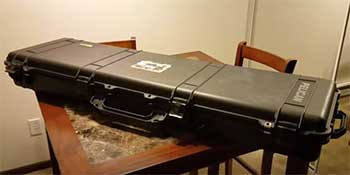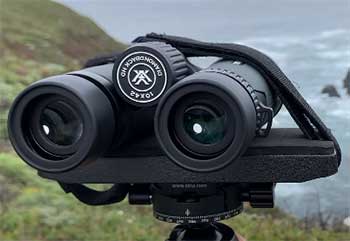Image stabilized binoculars can make a world of difference when you need a steady view, whether you’re tracking birds across the sky or gazing at stars and planets. Two of the top brands for this advanced optical technology are Fujinon and Canon.
But which is better for your needs?
In this in-depth guide, we’ll compare Fujinon and Canon image stabilized binocular models side-by-side. You’ll learn about:
- Key features of Fujinon vs Canon stabilized binoculars
- Image quality and stabilization performance
- Best uses for each brand (birding, hunting, astronomy, etc)
- Price differences
- Pros and cons of each
We’ll also answer some common questions about image stabilized binoculars so you can determine if they are worth the investment over traditional binoculars.
A Brief Comparison Table
| Feature | Fujinon | Canon |
| Stabilization Technology | Fujinon Image Stabilization Technology (F.I.S.T) | Vari-Angle Prism Image Stabilization (VAP-IS) |
| Stabilization Effectiveness | Excellent, counters up/down shake | Extremely effective, counters multi-axis subtle shake |
| Battery Life | Up to 10 hrs runtime | Up to 12 hrs runtime |
| Weight | Lighter due to stabilization system | Slightly heavier prisms |
| Image Quality | Extremely sharp across field | Equivalent sharpness to Fujinon |
| Field of View | Wider FOV at same magnification | Narrower FOV but with sharpness at high zoom |
| Low Light Ability | Same as Canon with same objective size | Similar light gathering as Fujinon |
| Durability | Made in Japan, very durable | Fully water/fog proof but not quite as rugged |
| Price | $100 – $300 higher than Canon | More affo |
Overview of Fujinon and Canon Image Stabilized Technology
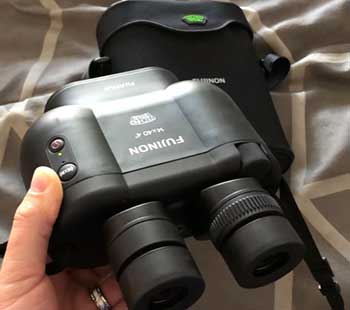
Both Fujinon and Canon use prism-based systems to stabilize the image you see when looking through their binoculars.
Prism-based image stabilization works by having gyro sensors detect shaking motion and then moving a prism inside the binocular to compensate.
This keeps the view steady even if your hands shake a little.
Fujinon calls its prism stabilization technology Fujinon Image Stabilization Technology (F.I.S.T). Canon uses Vari-Angle Prism Image Stabilization (VAP-IS).
While the underlying technology is similar between the two brands, there are some key differences:
- Stabilization effectiveness: Both work well, but Canon VAP-IS is able to compensate for subtle shaking across more axes of motion. Fujinon F.I.S.T counteracts up and down shake primarily.
- Battery life: Fujinon binoculars get up to 10 hours continuous use per battery while Canon claims up to 12 hours runtime.
- Weight: Fujinon’s prism system adds less weight than Canon’s, making their bins slightly lighter overall.
Now let’s dive into some of the top individual stabilized binocular models from each brand.
Also Read: Differences Between Leica And Swarovski Binoculars.
Comparison of Fujinon And Canon Binoculars
Now that we’ve explored some of the best individual stabilized binoculars from Fujinon and Canon, let’s directly compare the two brands. Here are some key considerations:
Image stabilization effectiveness
- Both Fujinon and Canon use quality prism stabilization systems that help eliminate handshake, even at high magnifications.
- Canon’s VAP-IS system seems to have a slight edge, compensating for more subtle shaking in all directions. But both are excellent.
Image quality and clarity
- Reviews indicate Fujinon and Canon are very close in optics quality. Both deliver bright, crisp viewing across the full field when properly focused.
- At extreme 18x zoom, Canon may pull ahead slightly in resolution of tiny details. But for most uses, clarity is comparable.
Field of view
- Fujinon tends to have wider fields of view at equal magnifications. This makes it a bit easier to keep fast moving subjects centered.
- Canon’s higher powered 18x glass has a relatively narrow field but makes up for it with excellent image sharpness.
Light gathering ability
- With the same objective lens size, Fujinon and Canon are quite close in low light performance.
- For dim conditions, go with the largest front lenses you can reasonably carry and stabilize.
Durability
- Both brands deliver waterproof, fogproof bins suited for outdoors use. Fujinon bins may withstand slightly rougher handling.
- Expect at least 10-12 hours runtime per battery charge for image stabilization.
Price
- Fujinon bins run $100 – $300+ more than Canon models with equivalent features.
- But you pay more for Fujinon’s made in Japan quality. Canon provides better value at lower price points.
Overall, Fujinon stabilized binoculars excel in durability and optics while Canon leads in stabilization technology and price. Both are excellent options that won’t disappoint.
Fujinon Techno-Stabi Image Stabilized Binoculars
Fujinon’s line of Techno-Stabi binoculars are well-known for their excellent image stabilization quality. Here are some of their most popular models:
Fujinon Techno-Stabi 14×40
Key specs:
- Magnification: 14x
- Objective lens diameter: 40mm
- Field of view: 114 ft at 1000 yards
- Eye relief: 15mm
- Close focus distance: 16.4 feet
- Weight: 42.1 oz
The 14×40 model is a mid-sized option that offers a good balance of magnification power, light-gathering ability, and portability. The generous 15mm of eye relief makes them comfortable for eyeglass wearers.
In reviews, the 14×40 Techno-Stabis get high marks for their sharpness across the field of view and effectiveness at eliminating handshake jitter even at full zoom. The stabilization lets you enjoy wobble-free viewing during lengthy observation sessions.
The downsides of this model are the shorter close focus distance compared to other Fujinon bins and the relatively heavy weight. But overall, it’s one of the best image stabilized binoculars on the market in this magnification range.
Also Read: Differences Between Leica And Zeiss Binoculars.
Fujinon Techno-Stabi 16×70
Key specs:
- Magnification: 16x
- Objective lens diameter: 70mm
- Field of view: 96 ft at 1000 yards
- Eye relief: 17.5mm
- Close focus distance: 16.4 feet
- Weight: 74.8 oz
Stepping up to the 16×70 model gets you a brighter view and higher magnification to resolve more detail at long distances.
These hefty Fujinon’s really shine for scanning open landscapes early in the morning when light is dim. The generous 17.5mm of eye relief means you can wear glasses and still enjoy the full field.
Reviewers say the 16×70 Techno-Stabis deliver tack-sharp images across a wide field of view. The stabilization lets you take full advantage of the high power without hand shake ruining the view.
The downside is that larger 70mm objectives make them very heavy. You’ll definitely want to use a tripod or window mount when glassing for extended periods. But for serious long-range viewing, the 16x70s are hard to beat.
Fujinon 7×50 Techno-Stabi JR
Key specs:
- Magnification: 7x
- Objective lens diameter: 50mm
- Field of view: 420 ft at 1000 yards
- Eye relief: 25mm
- Close focus distance: 16.4 feet
- Weight: 41.6 oz
Fujinon also makes the 7×50 model specifically designed for younger users with its wide 25mm of eye relief. It’s still fully waterproof and fogproof.
The generous 7x magnification range makes it easy for kids to get on target. And the Techno-Stabi prism system gives a study view even for beginners.
While the 50mm objectives don’t gather as much light as the larger 70mm lenses, they help keep the size and weight manageable for youngsters on the trail.
For an image stabilized binocular that will grow with a child over years of hiking, backpacking, and exploring nature, the kid-friendly 7×50 Techno-Stabi JR is a great choice.
Top Canon Image Stabilized Binocular Models
Now let’s look at some of Canon’s best image stabilized binoculars showcasing their Vari-Angle Prism stabilization technology:
Canon 12×36 IS Binoculars
Key specs:
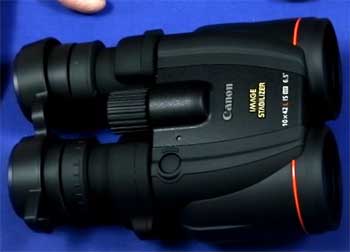
- Magnification: 12x
- Objective lens diameter: 36mm
- Field of view: 234 ft at 1000 yards
- Eye relief: 15mm
- Close focus distance: 8.2 feet
- Weight: 24.7 oz
Lightweight and compact, the Canon 12×36 IS binoculars are highly portable and great for travel.
The 12x magnification gives you decent reach while the smaller 36mm objectives are better suited for brighter daylight conditions.
Reviewers say the dual-mode image stabilization works incredibly well in both normal shake and severe shake modes. At 12x power, just your heartbeat alone can cause visible shaking, so having top-tier image stabilization makes a huge difference in usability.
The downsides are the narrower field of view compared to wider aperture models and less light gathering ability. But if you want a high quality stabilized binocular that won’t weigh you down, the Canon 12×36 IS model is an excellent choice.
Also Read: Differences Between Vortex Copperhead And Crossfire Binoculars.
Canon 15×50 IS Binoculars
Key specs:
- Magnification: 15x
- Objective lens diameter: 50mm
- Field of view: 285 ft at 1000 yards
- Eye relief: 15mm
- Close focus distance: 16.4 feet
- Weight: 37.9 oz
Stepping up to 15x magnification, this Canon glass combines powerful reach with mid-size 50mm objectives that balance light gathering ability and portability.
Users praise the 15×50 IS model for providing tack sharp images even fully zoomed in thanks to the highly effective stabilization. The long close focus distance allows you to view nearby subjects in fine detail.
The drawback is that the 15x magnification accentuates even subtle hand shake without stabilization engaged. But with the VAP-IS system on, the view steadies nicely for crisp long-range observing.
For a versatile mid-powered image stabilized binocular, the Canon 15×50 IS hits the sweet spot.
Canon 18×50 IS Binoculars
Key specs:
- Magnification: 18x
- Objective lens diameter: 50mm
- Field of view: 234 ft at 1000 yards
- Eye relief: 15mm
- Close focus distance: 16.4 feet
- Weight: 39.7 oz
On the high magnification end, the Canon 18×50 IS binoculars combine an extremely powerful 18x zoom with bright 50mm objective lenses.
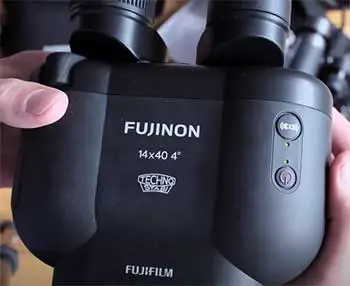
The potent 18x magnification requires excellent stabilization to be usable.
Fortunately, the VAP-IS system in this Canon glass lives up to the challenge.
Reviewers report the image stabilization makes a “huge difference” at full 18x zoom.
Tiny details on birds and other distant subjects pop thanks the sharpness and steady image.
Downsides are the very narrow field of view at high power. And the necessity of using stabilization even in mild conditions to get a shake-free view. But for picking out small, distant details, the impressive 18×50 IS model is hard to beat.
Are Image Stabilized Binoculars Worth the Cost?
The big downside of Fujinon and Canon stabilized binoculars is their high price compared to traditional roof prism binos.
But for certain uses, paying more for image stabilized glass can definitely be worth it:
- Bird watching – Tracking small birds on the wing at high magnification is extremely difficult without stabilization. Fujinon and Canon’s systems allow you to zoom in fully and still view a steady image as birds dart around.
- Hunting – Spotting animals hiding in brush at a distance is much easier with a stabilized view at 8-15x magnification. Sudden movements won’t throw off your sight picture.
- Astronomy/stargazing – High zoom binos need stabilization to see planets and stars clearly. Canon and Fujinon’s systems let you view deep space objects from a wavering tripod without blurring.
- Boating/maritime uses – On the open water, image stabilization allows you to scan the seas and shoreline without seasickness-inducing shaking.
So if you regularly use high magnification views for critical observing tasks, the benefits of Fujinon or Canon stabilization makes them well worth the premium price. But for more casual use, standard roof prism binoculars will usually do just fine.
Also Read: Comparison of Magview And Phone Skope.
Frequently Asked Questions (FAQ)
Yes, image stabilized binoculars can provide a drastically steadier viewing experience compared to traditional binoculars. By using internal gyro sensors and moving prisms to counter shaking motion, brands like Canon and Fujinon allow sharp viewing even at high zoom levels. Stabilized bins excel at tracking moving subjects like birds or game. They also enable clear, jitter-free viewing from unsteady platforms like boats or tripods.
For astronomy and stargazing uses, look for image stabilized binoculars with magnifications of 10x or higher. Objectives of at least 50mm will help gather enough light from dim celestial objects. Top picks are the Fujinon Techno-Stabi 16×70 and Canon 18×50 IS models. The powerful zoom and high quality stabilization let you view planets and nebulae from a telescope mount without blurring.
Fujinon binoculars are made by the Fujifilm company, a leading Japanese optics manufacturer. Fujinon is their high end line aimed at demanding fields like broadcast TV lenses. All Fujinon binoculars are engineered and produced at Fujifilm facilities in Japan. Their reputation for precision and quality has made Fujinon a top choice for stabilized astronomy and maritime binoculars.
Yes, Canon binoculars offer excellent quality and performance on par with other major optic brands like Nikon. Their image stabilized models like the Canon 18×50 IS utilize highly effective stabilization technology to deliver tack sharp viewing even at high zoom levels. And prices are generally lower than competitor stabilized binos from Fujinon or Zeiss. Canon’s wide range ensures good options for any budget or magnification needs.
Conclusion
Both Fujinon and Canon make excellent image stabilized binoculars that excel for uses like birding, hunting, astrophotography, and boating. Fujinon bins offerMade in Japan quality and durability at a premium price while Canon provides innovative stabilization and great value.
When shopping, consider your magnification needs, light gathering ability, and budget. But you can be confident choosing Fujinon for ultimate quality or Canon for price and technology.
Either brand of stabilized binoculars will take your long distance viewing to the next level with shake-free handheld or tripod use.
